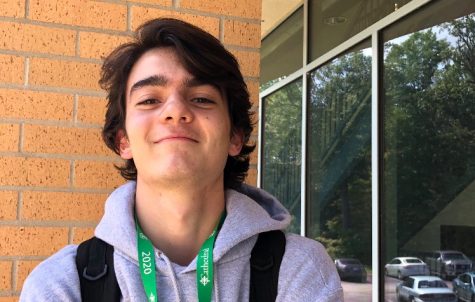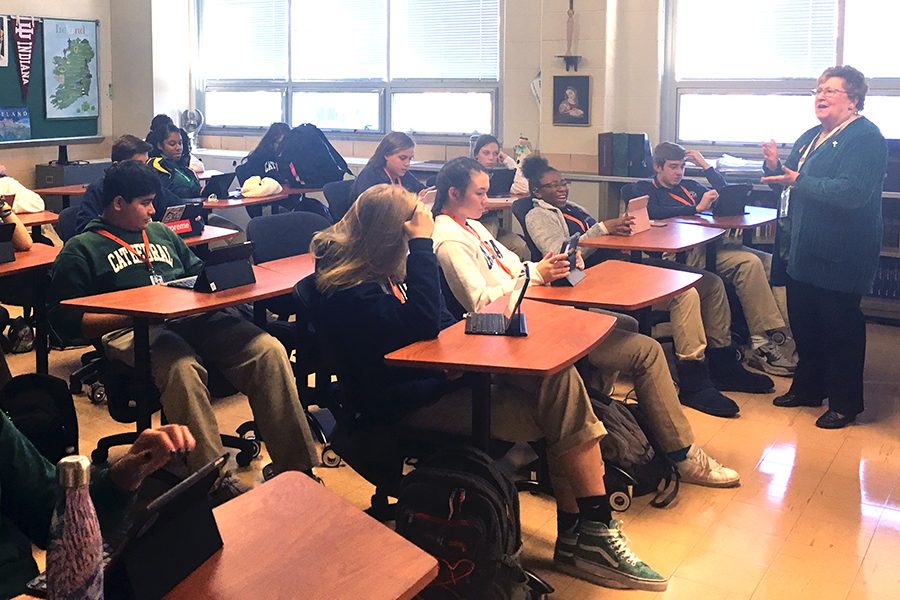Senate contest among key races in Nov. 6 election
Indiana could help determine majority party
Sr. Mary Ann Stewart instructs her G period history class on Oct. 17. Sr. Stewart said she encourages all students who registered to vote to cast their ballot on Nov. 6.
It may be difficult to believe that it has almost been two years since the 2016 presidential campaign during which America saw candidates Hillary Clinton and Donald Trump battle it out to win over the hearts of the nation. Now, the country prepares for the Nov. 6 midterm elections.
As 435 seats in the House of Representatives and a third of the Senate seats (including one of the two in Indiana) are up for election, as the country is waiting to see who will fill the vacant chairs and serve their state. and perhaps change the party in control of the Senate, which is now 51-49 Republican.
Indiana will see Republican candidate Mike Braun for United States Senate, Democratic candidate and incumbent Joe Donnelly and Libertarian candidate Lucy Brenton continue to vie for voters’ attention as the election draws nearer.
Both the Democratic and Republican candidates for the U.S. Senate in Indiana have flooded the local television stations with advertising as the campaign continues.
Ms. Jill Baisinger, an AP social studies teacher, noted how the midterm elections provide a way of keeping a check on the current president during his term.
This midterm specifically will focus on the efforts of Trump and whether or not he has lived up to his campaign promises and has served the American people in accordance with a majority of their party’s wishes. Currently, the Republican Party holds the majority in both the House of Representatives and Senate, which Baisinger said is referred to as a unified government.
The Democrats will look to change that in November as they hope to reverse the effects of Trump and his administration and take back control within both the House and the Senate.
Baisinger said, “Either party wants to control the House or the Senate because they want to see their policies advanced.” She continued by saying that if a party loses control of either political body, it becomes more difficult for that party to push its agenda, and they will end up seeing the opposite agenda pushed instead.
In terms of current political issues, Baisinger said voters usually tend to focus on unemployment, the economy and any issues affecting their families. She went on to mention how conservative values tend to guide Indiana families when voting, given the state’s location in the Midwest.
Voting takes place on Nov. 6, with polls open from 6 a.m. to 6 p.m. Indiana residents who are registered to vote may find their polling location by going to indianavoters.in.gov and entering their first and last name, age and street address.
First-time voters are reminded that they must show a valid ID, such as a driver’s license or passport. No, your beloved ID hanging on your Cathedral color-coded lanyard won’t work.
Sr. Mary Ann Stewart will cast her ballot, as she said she has never missed a vote since she was first able to do so in 1968. She noted that one of the individuals for whom she cast her first vote was Sen. Robert F. Kennedy, who won the presidential primary in Indiana but was assassinated in June after he won the California primary.
She says by having the right to vote but then by choosing not to case your ballot “you are giving more power to people who did (vote).”
One senior who plans to take Sr. Stewart’s advice is senior Abby Thomas, who will vote for the first of November. Thomas said “Choosing the people that will represent our voices, both locally and nationally, is of the utmost importance in ensuring the government will reflect each citizen’s beliefs.”

Nic Napier is a senior and the Co-Editor-In-Chief of the Megaphone this year. Along with newspaper, Nic is involved in several activities and clubs on...

Ava Amos is a senior and is the co-editor-in-chief of the Megaphone staff. She is a member of the varsity softball team and enjoys volunteering with the...







